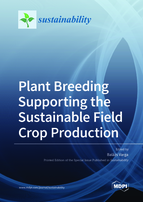Plant Breeding Supporting the Sustainable Field Crop Production
A special issue of Sustainability (ISSN 2071-1050). This special issue belongs to the section "Sustainable Agriculture".
Deadline for manuscript submissions: closed (30 September 2022) | Viewed by 27619
Special Issue Editor
Interests: breeding; abiotic stress tolerance, plant protection; improving adaptability of plants; increasing water and nutrient use efficiency; effects of climate change; elevated CO2
Special Issue Information
Dear Colleagues,
Improving the sustainability of agricultural production has key importance in minimizing its negative environmental impacts. The efficiency-targeted technologies (low-input farming, water-sawing tillage, etc.) could be only effective if the harvested crop can also make the most of the resources. Plant breeding is the first step of achieving sustainable farming besides the technology development because the plant's adaptability, resistance and yielding capacity could be driving factors in realising these goals.
Climate change and extreme weather events such as droughts, heat waves, floods and frost are the major factors that underline the need for varieties and hybrids having wide adaptation capacity. The changing environmental conditions support the spreading of invasive pests and weeds, further making favourable conditions for the distribution of plant diseases. Therefore, the modern breeding programme should focus on improving abiotic and biotic stress tolerance and biodiversity as well.
Agriculture, especially field crop production, is in charge of environmental pollution and reducing biodiversity and the health status of ecosystems. Water scarcity is a merging issue worldwide; therefore, improving the water and nutrient use efficiency of the cultivated crops could contribute to reserving the limited resources. The reduction of water demand could decrease the yield losses under drought conditions and lower irrigation-water demand could prevent the destruction of soil conditions, while soil health status is also a key factor in field production.
This Special Issue will aim to share the results of the recent researches from all over the world and highlight the attention of the scientific community to research topics. Furthermore, this Special Issue could contribute to the implementation of actual knowledge into practice which would be an essential step to meet the goals of sustainable agriculture.
Dr. Balázs Varga
Guest Editor
Manuscript Submission Information
Manuscripts should be submitted online at www.mdpi.com by registering and logging in to this website. Once you are registered, click here to go to the submission form. Manuscripts can be submitted until the deadline. All submissions that pass pre-check are peer-reviewed. Accepted papers will be published continuously in the journal (as soon as accepted) and will be listed together on the special issue website. Research articles, review articles as well as short communications are invited. For planned papers, a title and short abstract (about 100 words) can be sent to the Editorial Office for announcement on this website.
Submitted manuscripts should not have been published previously, nor be under consideration for publication elsewhere (except conference proceedings papers). All manuscripts are thoroughly refereed through a single-blind peer-review process. A guide for authors and other relevant information for submission of manuscripts is available on the Instructions for Authors page. Sustainability is an international peer-reviewed open access semimonthly journal published by MDPI.
Please visit the Instructions for Authors page before submitting a manuscript. The Article Processing Charge (APC) for publication in this open access journal is 2400 CHF (Swiss Francs). Submitted papers should be well formatted and use good English. Authors may use MDPI's English editing service prior to publication or during author revisions.
Keywords
- plant breeding
- drought stress
- salinity
- heat stress
- fertilization
- irrigation
- water uptake
- water use efficiency
- nutrient use efficiency
- pest and diseases resistance
- disease and weed control, organic plant production
- low-input farming






